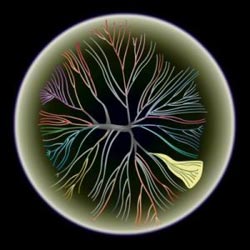Single-celled organisms also have communication systems
When it comes to cellular communication networks, a primitive single-celled bacterium called Monosiga brevicollis outperforms animals with billions of cells. Researchers at the Salk Biological Research Institute have discovered that it controls a more complex and diverse signal network than any of the higher-level multicellular organisms in evolutionary plants.
Their study, published week 7-7 July online in the Proceedings of the National Academy of Science, discovered 128 genes of tyrosine kinases, more than those of 38 genes.
These kinases transmit the signals needed for cell growth, stagnation and termination. Although their activity is tightly regulated by normal cells, out-of-control kinases are a major cause of cancer. Many successful cancer drugs - such as Gleevec, used to treat leukemia - target these stubborn kinaza.
The new and completely new treasure of tiroxin kinaza makes the main author of the study, Gerard Manning, the director of Razavi-Newman Biological Center, very surprised because of the long-term effects of tyrosine kinza. Drought in multicellular animals, they handle contact between cells.
Manning said: 'We were completely taken aback. Based on previous studies, we only expect to find a few kinases, but instead we discovered a record number of primitive organisms. Two other important components in the tyrosine kinase network - PTP and SH2 genes - are also more numerous than any genome, suggesting the complexity of the entire network in this species. '

Phylogenetic plants, which show an evolutionary relationship between the tyrosina monosiga and the tyrosine, suggest that only a few of them have a family name of tiroxin kinase in humans (yellow).(Photo: Dr. Gerard Manning, Salk Institute of Biological Studies)
Hundreds of trillions of cells in our bodies need a complex communication system to link their activities. Cyanine kinaza is the survival part of the communication system. This is an extremely well-studied enzyme that acts as an receptor for external signals such as growth signals and then transmits messages to cells by attaching a group of phosphates to proteins.
Monosiga brevicollis belongs to the choanoflagellates group, which is a gray aquatic creature between the mushroom kingdom and the animal. It has very little in common with multicellular animals that need to link the activity of billions of cells. However, its original structure - the tentacle ring surrounding the whip-shaped tail is called flagellum - basically the same as the 'collar cell' that gathers to form the sponge, which is considered the most primitive form of multicellular organisms or metazoan.
Because of its decisive evolutionary role, M. brevicollis was selected as a choanoflagellate representative for whole genome sequencing. Manning said: 'Choanoflagellates are like' first relatives 'of animals and their genomes give us a vague idea of the evolutionary origin of animals.'
Monosiga kinza separates more than any animal, which could help scientists understand the basic principle of the signaling of tyrosine kinase. Despite its diversity, kinase monosiga offers the same solution to a problem at the same time, like kinases in animals, however they use a different method to create a sympathetic structure. Get born from the cell, or to determine the target for a kinaza to a certain part of the cell. Manning said: 'This convergent evolution shows that there are only a few certain ways to build a functional network from these components.'
With the new information, an obvious question remains unanswered: what kind of communication does this single-celled organism use for communication? Manning admitted: 'We still have no clues! But this discovery is the first step to finding that out. '
- There is a single-celled creature that has the power to change the world
- Differences between viruses, bacteria and parasites
- Scientists discovered LUCA, a single-celled organism thought to be the ancestor of life
- Almost lost his life because the parasite eats meat
- Creating multicellular life in vitro
- Create a robot that simulates intestinal bacteria
- The mysterious 'strange' gene in the human body
- Surprisingly, the ability to 'copy the original' of the slime mold
- Biological Era 2.0: When people accelerate evolution and create completely new creatures
- US launches 'communication' technology for automobiles
- Discovering strange creatures without brains, one eye can eat meat
- Life on Earth may have started over 4 billion years ago
 Why do potatoes have eyes?
Why do potatoes have eyes? 'Tragedy' the world's largest carnivorous life: Death becomes ... public toilet
'Tragedy' the world's largest carnivorous life: Death becomes ... public toilet Tomatoes were once considered 'poisonous' for 200 years
Tomatoes were once considered 'poisonous' for 200 years Detecting microscopic parasites on human face
Detecting microscopic parasites on human face